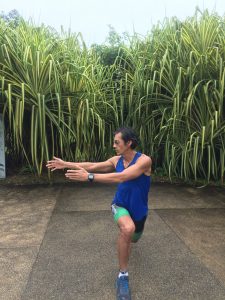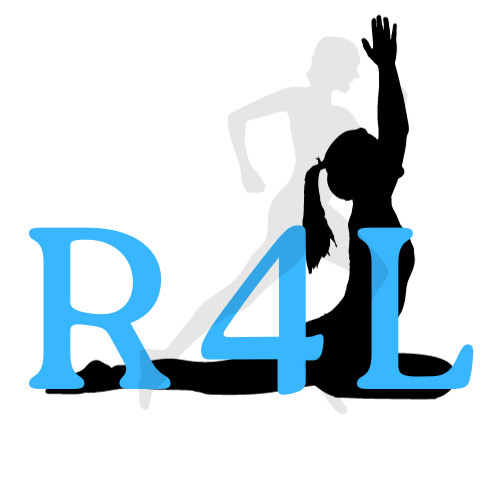Last week I went for a run with my friend Enrico, Kona IM finisher, Boston marathon finisher, author of Clock Your BQ, trainer and coach. I had wanted to seek his opinion on a warm up routine, which I was asked to conduct for an event. Stay tuned here for a piece on that event.
This run turned out to be a masterclass by the eloquent trainer himself.
It was a lightly drizzly morning out on East Coast beach. Certainly a cool and refreshing morning for a run. We met about 2km into his run, I seamlessly melded into his stride and a nice 5:40 pace. My intention was to pick his brains and to have Enrico model the photos for my dynamic warm up routine. I got those and much more.

Enrico modelling the forward lunge with a twist
Enrico showed me:
- A posture and form for efficient running. If you ever so slightly thrust your core forward while running, it will make it easier for you to lift your foot. In this way, you spend less energy going forward.
- A way to diagnose cadence and footfall. This is important to keep pace. You want to have rhythm (cadence) and soft footfall will ensure you do not injure yourself. He taught me to have my trainees run on sand and observe the foot prints and thence correct the footfall.
- The case for cross training.
Two of the roles that coaches play are to impart knowledge, showing you the right way to do things, and to motivate and cajole you to do your best. Having imparted his knowledge, Enrico proceeded to push me to keep pace with him.
I consider myself fit, though not as fit as an IM finisher or someone who at 50 completes a marathon in 3hrs 20minutes. At 30, I can hold 5min pace over half marathon but now at 51, I can only hold a 5:20 pace for no more than 7km. But that morning, Enrico encouraged and cajoled me to keep a pace of 5:20 with him over 10km. The final km I was doing 4:50 min pace.
Excellent stuff. Thanks Enrico.
And then over the weekend this.
I am preparing an assault at a post 45 PB on the half marathon. My training plan for last Saturday was an LSD over trail to build endurance. 16km was the target. For some reason, that planned LSD turned out to be an attack the hills tempo run of only 12km. Well I do know the reason. It was lack of discipline. I was egged on by ego and the excitement of kicking up the hills at MacRitchie. I did not stick to plan and therefore the training target was not met. I had done what I have told my trainees not to do. Chuck the plan and go.
These 2 runs over the last week, brought home the case for why you need a coach. Even a coach need a coach.
What are the roles that coaches play? Coaches are advisors, counsellors, friends and supporters, facilitators, instructors and teachers, motivators, role models and mentors. Coaching be it for fitness, for life or professional goals will give you or an organization the following benefits:
- Establish and take action towards achieving goals. One of my trainees commented to me had he been left on his own, he would not have gone and started working out.
- Increased confidence. I was certainly more confident with my pace after that session with Enrico, perhaps this was why I went on the attack the hills mode last Saturday.
- Generates learning and clarity for forward action with a commitment to measurable outcomes. My trainees, before my sessions had no idea on the measurements used to measure his fitness. He thought that fitness relates to only his weight and the measurement of his waist. Now he is eager to learn about VO2 max. I certainly did not know how to diagnose footfall and the importance of a light footfall before my session with Enrico. Now I am able to use that knowledge to improve my pace and to teach my trainees.
- Improved performance. With more knowledge and the motivation and cajoling of coaches, a trainee will certainly improve his or her performance. Enrico’s motivation during the run with him pushed me to go 3km longer at 5:20 pace than I usually do. So too, my cajoling and motivation had helped my trainees complete her 10km in 52 minutes. 8 minutes better than her goal.
- Increased ROI. Certainly with improved performance your return on investment is greatly improved too. whether this investment is in money, time or emotion.
The 2 sessions for me simply emphasised the need for coaches to teach me new things, to make me perform beyond my normal and give off my best and to keep my eyes on the goal. Immediate goal of the session, the intermediate goal and the long term goal.
Get yourself a coach.

I see your page is in the same niche like my page. Do you
allow guest posts? I can write interesting and unique content for you.
Let me know if you are interested.
hi, that’s an idea, let me see your page. maybe we could cross post
I must point out my admiration for your generosity for those who have the need for guidance on that field. Your special dedication to getting the message all-around turned out to be incredibly practical and has consistently allowed most people like me to reach their dreams. Your entire invaluable hints and tips indicates a great deal a person like me and further more to my fellow workers. Thank you; from all of us.
Thank you a lot for giving everyone such a memorable possiblity to read from this website. It is often so great and full of a lot of fun for me personally and my office mates to search your web site a minimum of thrice in a week to read through the new tips you have. And indeed, I am also certainly motivated with the great opinions served by you. Certain 3 ideas in this post are surely the most impressive we have had.
Thanks so much for giving everyone such a splendid chance to check tips from this site. It really is so beneficial and as well , jam-packed with fun for me and my office mates to visit the blog at the very least 3 times in one week to study the fresh secrets you have. And lastly, I’m just actually contented with your cool solutions you serve. Certain 1 tips in this post are in fact the best we have had.
I want to express thanks to this writer for rescuing me from this scenario. After researching through the internet and obtaining techniques that were not powerful, I figured my entire life was done. Existing without the approaches to the difficulties you have fixed as a result of your main site is a serious case, as well as ones that might have in a negative way damaged my career if I had not discovered your web site. Your primary talents and kindness in playing with all the stuff was very useful. I am not sure what I would have done if I had not discovered such a subject like this. I’m able to at this point relish my future. Thanks for your time very much for your specialized and sensible help. I won’t think twice to refer your web blog to any individual who should get care on this situation.
I actually wanted to develop a note in order to say thanks to you for all the pleasant tips and tricks you are posting at this website. My time consuming internet lookup has at the end of the day been paid with reliable facts and techniques to talk about with my friends and family. I ‘d point out that we site visitors actually are truly fortunate to dwell in a decent place with many marvellous people with good guidelines. I feel pretty grateful to have seen your entire web site and look forward to some more awesome minutes reading here. Thank you again for a lot of things.
I as well as my pals were following the good suggestions found on the website and then all of a sudden came up with an awful suspicion I had not expressed respect to the blog owner for them. All the young men happened to be for this reason joyful to see all of them and have now pretty much been taking pleasure in these things. I appreciate you for actually being so thoughtful as well as for using this form of great useful guides millions of individuals are really needing to be informed on. My very own sincere apologies for not expressing appreciation to earlier.
Thanks a lot for providing individuals with an extraordinarily brilliant possiblity to check tips from this web site. It’s always very terrific and full of a lot of fun for me personally and my office acquaintances to visit the blog a minimum of three times in a week to study the latest guidance you have got. Not to mention, I’m also at all times happy with all the surprising methods you serve. Certain 1 tips in this post are undoubtedly the most suitable we’ve ever had.
Thanks so much for providing individuals with an extraordinarily marvellous opportunity to discover important secrets from here. It is usually very excellent and as well , packed with fun for me and my office mates to search your web site not less than thrice in 7 days to find out the newest guidance you will have. Not to mention, I’m usually impressed with your awesome points you serve. Some 3 tips on this page are basically the most beneficial we’ve ever had.